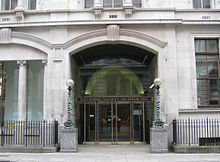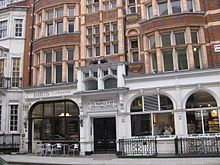|
Wimpole Street
 Wimpole Street is a street in Marylebone, central London. Located in the City of Westminster, it is associated with private medical practice and medical associations.  No. 1 Wimpole Street is an example of Edwardian baroque architecture, completed in 1912 by architect architects John Belcher and J. J. Joass as the home of the Royal Society of Medicine.[1] 64 Wimpole Street is the headquarters of the British Dental Association.[2] HistoryThe name Wimpole comes from the Wimpole Estate in Cambridgeshire, which in the 18th century was the seat of the Harley family, who developed the street. ResidentsOne of the residents most associated with the street was the poet Elizabeth Barrett, who lived at 50 Wimpole Street with her family from 1838 until 1846 when she eloped with Robert Browning. The street became famous from the play based on their courtship, The Barretts of Wimpole Street. The play starred Katharine Cornell, and when she retired, she moved to E. 51st St. in New York. As she was now neighbour to two other actors who also starred in the play, the street was nicknamed "Wimpole Street".[citation needed] Musical residentsThe first complete English performance of Brahms' Ein deutsches Requiem was performed on 10 July 1871 at 35 Wimpole Street, the private residence (from 1851) of the composer and pianist Kate Loder. The arrangement, which came to be known as "the London version", was for piano duet (played by Loder and Cipriani Potter) with soloists and choir. Around 30 voices were used in the performance.[3] Paul McCartney lived at the home of the Asher family at 57 Wimpole Street in 1964–1966 during his relationship with Jane Asher.[4] At this address John Lennon and Paul McCartney wrote "I Want to Hold Your Hand" in the front basement room, while McCartney wrote the tune to "Yesterday" in a box room at the top of the house.[5] Other notable residentsOn the corner of Wimpole and Wigmore Street took place a legal case about causing a "nuisance" between neighbours, in Sturges v Bridgman (1879). Arthur Conan Doyle, who created the character of Sherlock Holmes, worked and wrote in 2 Upper Wimpole Street in 1891. A green plaque has been installed to commemorate the cultural heritage of the City of Westminster. In 1932, Paul Abbatt and Marjorie Abbatt opened a toy shop, Paul & Marjorie Abbatt Ltd, designed by their friend, the architect Ernő Goldfinger, at 94 Wimpole Street.[6][7] The shop was unique in that children were allowed to touch and play with the displayed toys. List of residents
Fictional residents
In popular culture Virginia Woolf memorably describes Wimpole Street in Flush: A Biography, beginning: "It is the most august of London streets, the most impersonal. Indeed, when the world seems tumbling to ruin, and civilisation rocks on its foundations, one has only to go to Wimpole Street...".[10] The street was also given as the home of Henry Higgins by George Bernard Shaw in his play Pygmalion and in the musical adaptation My Fair Lady, with 27a given as the address. 22a Wimpole Street is referenced in the Monty Python sketch 'Secret Service Dentists'.[11] See also
ReferencesWikimedia Commons has media related to Wimpole Street.
|
Portal di Ensiklopedia Dunia